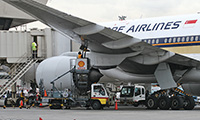News
Oil glut clouds fuel hedging strategy
Oil prices have dropped to their lowest level in almost four years, holding out the promise of lower jet fuel prices and a big reduction in airline operating costs. But in the Asia-Pacific, as elsewhere, airlines are wary that after the drop, there will be a price spike.
November 1st 2014
On the face of it, the dramatically lower oil prices of the last three months look good for Asia-Pacific carriers as they battle tough times on the profitability front. Until the demand fall off began in June, the average price of jet fuel was around $123 a barrel for the region’s airlines. Read More »
By October 3, prices per barrel were $107, some 13% less than a year ago, 7.4% lower than the same day in September and 3.2% under the price of a week earlier. Seven days later, it was down to $105.10 and in the Asia-Pacific, it was even lower at $102.10. Yet airline managements aren’t jumping with joy about news.
 |
Whichever way you look at it, said Tony Tyler, director general and CEO of the International Air Transport Association (IATA), fuel is still a major component of airline costs, at around 30% of expenses.
“The industry has done extremely well to adapt to rapidly rising fuel prices. A little over a decade ago, oil was less than $30 a barrel. Today, it floats around the $100 mark (last month the price of Brent crude temporarily dipped close to $80, its lowest level since 2010). There is little sign it will significantly decline and every chance, given the instability we see in some of the major oil-producing nations, that it could spike again,” Tyler said.
IATA’s regular airline financial review, covering September, said concerns about several geopolitical threats to crude oil supplies have been offset by increases in the oil supply in other regions, including the U.S. Some pessimism still exists about the demand outlook, with key regions like Europe forecasting slowing economic growth.
Oil prices have dropped dramatically, said commodity analysts, because faltering global growth had curbed demand for fuel in a period of heavy oversupply. In October, oil saw its biggest daily fall in more than three years. Since June the price of a barrel of oil has dropped by 26%. That, said the experts, was trigged by three events: a downgrade in global oil consumption forecasts; projections for another big boost in shale oil and reluctance by OPEC (Organization of the Petroleum Exporting Countries) members to cut output.
This time, Saudi Arabia made it clear it was focused on maintaining market share, not supporting prices with unilateral production cuts. Other countries, including Iran, Libya and the U.S. are following suit.
As a result some industry insiders believed the cost of a barrel of crude could drop to $70, although few believed it would dip below that level.
If the price remains low for a lengthy period it could impact seriously on the fuel hedging many airlines have in place. Carriers have stepped up their jet fuel hedge volumes, with some airlines locking in fuel purchases as far out as 2016. Those long-term positions, said analysts, suggested airlines see oil prices bottoming.
A recent Reuters survey revealed that Asia-Pacific carriers are hedging substantial portions of their fuel burn in expectation that prices will be firm, which will put pressure on profitability as competition from low-cost carriers intensifies.
Fuel traders at several regional banks, Reuters said, have noted a widespread pick-up in hedge interest as oil prices have dropped, and volumes rise as the fuel price keeps falling. However, if they are wrong, some airlines could have to pay more for fuel than the market value.
Japan Airlines is hedging about 40% of its fuel consumption in the 2014 financial year, which is similar to the volumes in 2013. All Nippon Airways’ ratio for its 2014 financial year is 45%, similar to the 2013 and 2012 fiscal years.
Korean Air generally keeps its hedging volumes around at 30% of its annual fuel consumption. Cathay Pacific Airways is hedging 25% for 2014 and the first half of 2015 at more than $94 to $95 a barrel, and about 11% for the second half of 2015 and the first half of 2016.
Qantas Airways is hedging as much as 94% of its fuel needs for the first half of next year, and Singapore Airlines is hedging around 52% for its 2014-2015 financial year.